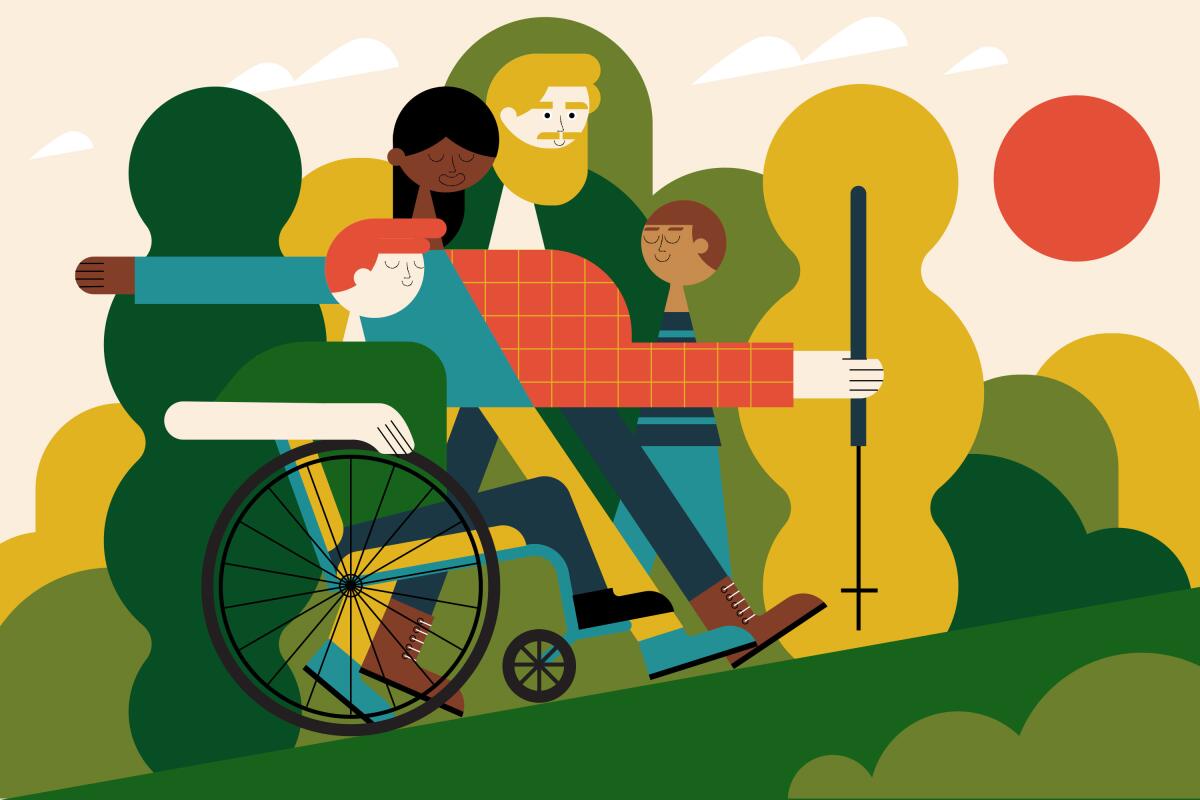
These 8 L.A. trails are accessible to everyone, from wheelchair users to kids in strollers
- Share via
We’re blessed with a wealth of beautiful and ecologically diverse trails in Southern California, from those that hug the rugged coastline to others that twist through pine-canopied canyons and pastel desert landscapes.
But most of these trails aren’t accessible to nature lovers with limited mobility, including people who use wheelchairs or other equipment to help them get around, folks who are older or have physical disabilities, and children who aren’t yet able to traverse rocky or steep inclines.
This guide features eight hikes and nature walks within an hour’s drive of Los Angeles that can be enjoyed by just about everyone.
Planning your weekend?
Stay up to date on the best things to do, see and eat in L.A.
We consulted with Ed Price, founder of the Trail Access Project, a nonprofit in Nevada that helps people with physical disabilities have safer and more meaningful outdoor experiences, to find out what makes a path accessible.
“What’s accessible for one person won’t be accessible for another,” Price stressed. But trails that can be enjoyed by the widest range of abilities do have a few things in common: they’re either paved or made from firm ground that wheelchairs can traverse safely; they’re at least three feet wide; and they have a low grade, meaning they’re relatively flat. They should also have accessible parking spots nearby. Resting areas and handrails are a plus.
In 2013, the U.S. Access Board issued new accessibility standards for trails on federal lands. The standards require new trails to have certain features that you can read about here (they mirror the characteristics we listed above, for the most part). California State Parks also follow these guidelines.
And yet accessible trails remain few and far between, in part because these guidelines are so new, and it takes a lot of work and money to build a trail that might be more accessible. “With some of these agencies, that hasn’t been a priority,” Price said.
There were four other trails we checked out that we didn’t end up including because they wouldn’t be usable for many people in wheelchairs.
One of them — Inspiration Point loop in Will Rogers State Historic Park — was explicitly labeled an accessible trail. And while it technically may have met the federal accessibility standards, we found it too bumpy and steep to be on this list. We also visited Griffith Park’s Fern Dell Nature Trail, which we thought would be a given to include because of its reputation as a gentle, family-friendly stroll. And it is, in many ways. But the path has steps built into it, it was narrow and uneven in many spots, and there weren’t accessible parking spots close by. This process really showed us how challenging it can be to find trails that are built for people of all abilities.
Everyone should be able to enjoy the outdoors, and we hope this list will make doing so a little easier. Happy hiking!
Mount Wilson Observatory
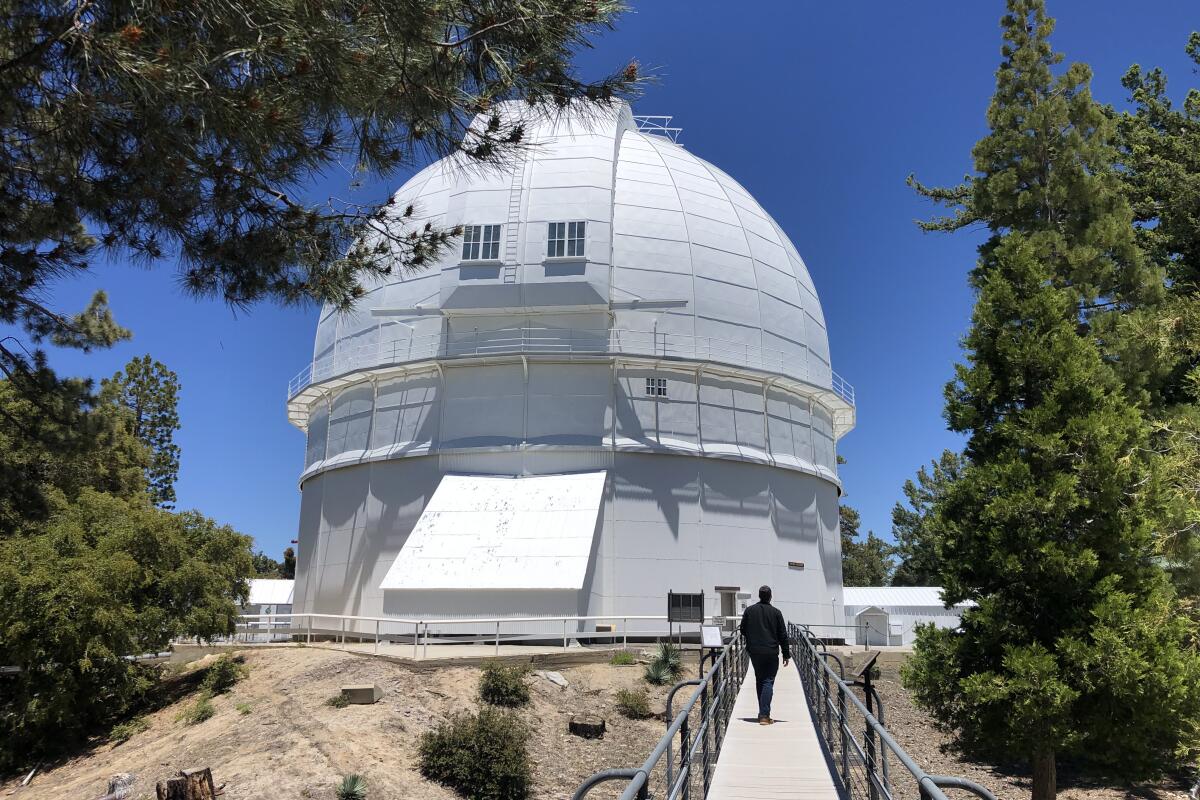
For best accessibility, park in the main lot just as you enter the observatory’s grounds and journey up the path that begins just past a sign that reads “authorized vehicles only.” Of this entire one-mile walk, this part may be the most difficult for some, as it sits at a slight incline for roughly 0.1 miles. Shortly after, though, the path levels out, leading you past a live oak grove, sugar pine trees and big cone Douglas firs, as well a one-room museum that narrates the development of the observatory and astronomical knowledge. The main path has branches that diverge to the different telescopes and picnic benches at stunning mountain overlooks.
Start or end your journey at the Cosmic Cafe, where you can enjoy a banana split or pie a la mode. Depending on your mobility, you may need to drive to the upper parking lot, which has a paved path that leads to the cafe.
You’ll need an Adventure Pass to park, as is the case anywhere in Angeles National Forest.
El Dorado Nature Center

First, stop inside El Dorado’s kid-friendly nature museum, where you can learn more about the flora and fauna in the park (there are an estimated 150 different species of birds at the center, along with turtles, snakes, raccoons, foxes, rabbits and skunks). Directly behind the museum is a paved half-circle that faces one of the park’s two lakes, which are connected by a meandering stream. This is an ideal spot to take in the scenery before or after you hit the trail.
From the back of the welcome center, loop to the right, cross the bridge over the lake (stop to look for turtles!) and you’ll find a sign that indicates two paths: the one- and two-mile trails and the 0.25-mile trail. If you’re using a wheelchair or can’t walk up inclines, take the 0.25-mile trail. It’s entirely paved, very flat, and has handrails the entire way. The jungly tree canopy was my favorite part of this walk; I almost forgot I was in a city. Native plants like California buckwheat and monkeyflower line the pathway. There are several benches along the way for either rest or contemplation.
There are two longer trails (one mile and two miles), which, though unpaved, are mostly flat, except for a few steep switchbacks at the start. Wheelchair users may have a hard time using this one without assistance.
Parking will cost you $6 on weekdays and $8 on weekends; there are seven accessible spots next to the park entrance.
Bolsa Chica Ecological Reserve
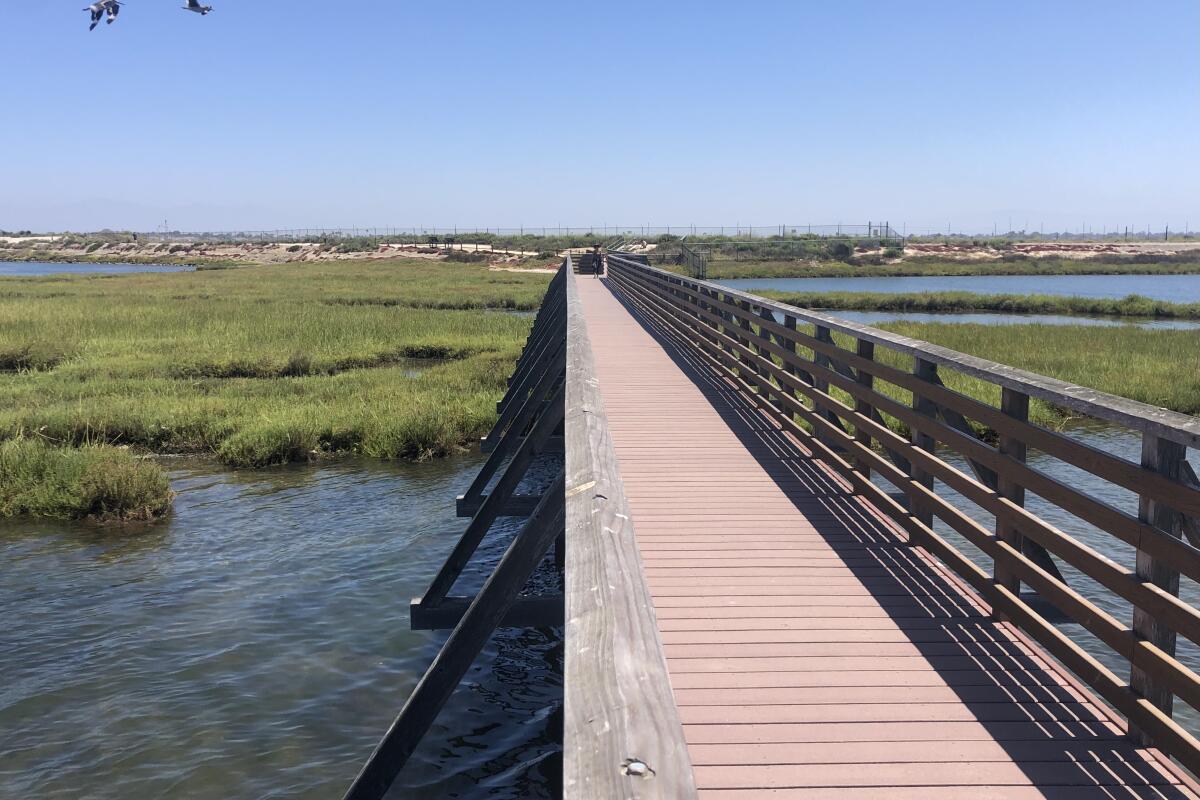
The reserve has over three miles of accessible trails, from paved to compact dirt to boardwalks, and will accommodate all types of wheelchairs. The paths take you over rippling waterways and bright-green pickleweed and cordgrass. When I visited in early August, I watched striped mullet leap from the water and flocks of seabirds skim the surface of the wetlands. There are several benches in prime bird-watching spots.
I recommend parking in the lot just off Highway 1, where two accessible spots are just a stone’s throw from an idyllic boardwalk.
Placerita Canyon Nature Center

Park at the nature center to access a wide paved path that will take you past a historic cabin built by homesteaders, a butterfly garden, and interpretive signage about the land’s human and natural history. A main attraction is the “Oak of the Golden Dream,” the 500-year-old tree where mineralogist Francisco López made California’s first documented discovery of gold in 1842. To reach the storied oak, you’ll travel beneath an underpass along the babbling creek, replete with handrails and colorful murals.
The Ecology Trail is a compact dirt path that’s accessible from the Nature Center parking lot. It’s too narrow and bumpy in parts for wheelchairs, but it may be workable for people with other mobility limitations for a short while until you hit inclines and a set of steps. This trail boasts a notable abundance of native plants, including purple sage, mugwort, elderberry, and toyon — and they’re labeled, so you can learn as you mosey. Along this path you’ll also see a re-creation of what a Tataviam dwelling looked like when the Native American tribe inhabited the area from AD 450 until Spanish colonization.
West Fork National Scenic Bikeway

This is the only paved path of its length that’s open to the public in Angeles National Forest. The entire trail parallels the cool and clear West Fork San Gabriel River and is canopied with sycamore, white alder and willow trees. You’ll still get plenty of direct sunlight on this walk, though, so keep that in mind during the summer.
On a hot day, the first mile is likely to be bustling with local families cooling off in the river. But keep moseying and you may very well be rewarded with relative solitude. The path is mostly flat, but if you’re using a wheelchair you may need some help on the first half mile, as there’s a slight incline and patches of cracked, bumpy pavement.
Those with limited mobility may want to turn around at 2.8 miles (you’ll see a small, sweet waterfall to your left) where this 7-mile-long trail starts getting steeper.
There’s a lot close to the trailhead with three accessible spots. Unfortunately, the bikeway is closed on weekdays through the end of 2023. When I went on a recent Sunday, though, I had no problem getting a parking spot. Just get there early.
Kenneth Hahn State Recreation Area
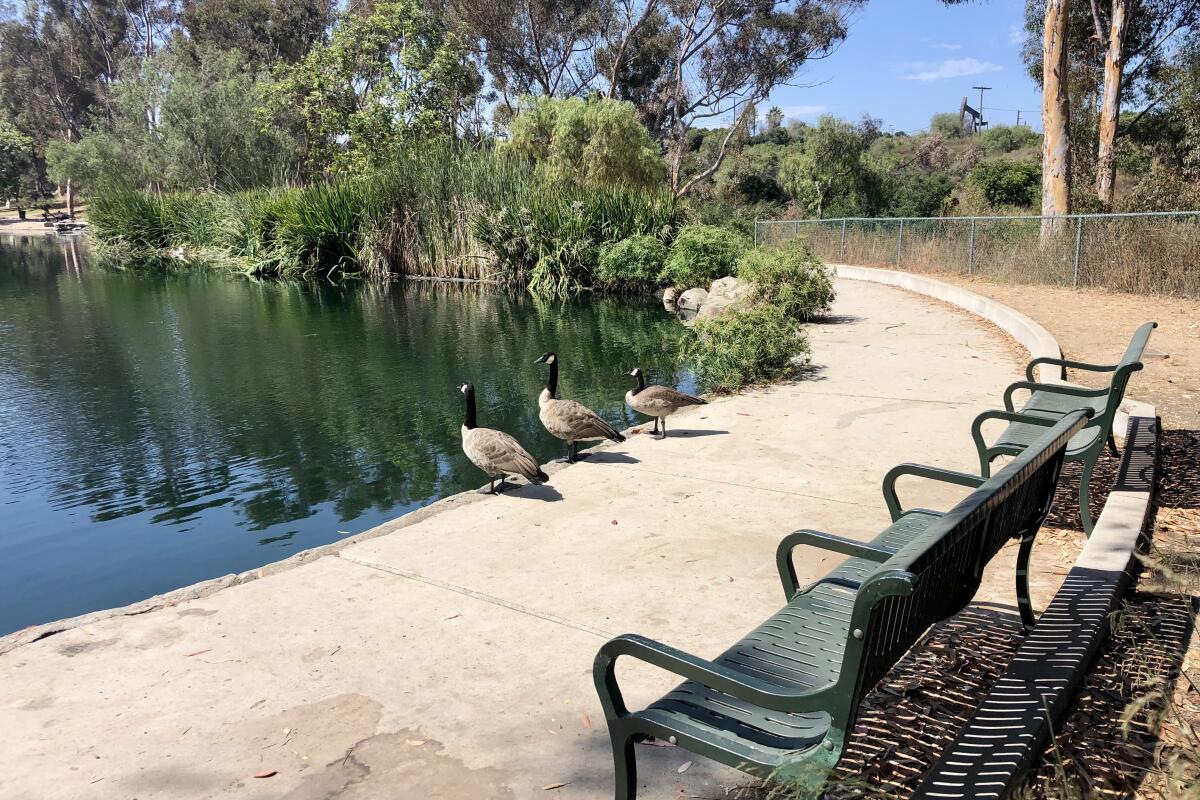
The first is at the man-made Gwen Moore Lake, which is surrounded by a flat, paved walkway that’s just over a quarter-mile long. Towering eucalyptus trees shade the path that features accessible cutouts where wheelchair-users can fish or watch the ducks and turtles. The parking lot at Gwen Moore has seven accessible spots.
If you’re looking for a longer, more immersive walk, check out the trail that starts at Burke-Roche Picnic Area, which also has a number of accessible parking spots. The loose gravel path is hugged by scrubby native plants and features wooden handrails and sweeping views of the city. You’ll pass a hummingbird garden, where you can watch the buzzy little birds flit about various feeders. Stay right on the trail for about half a mile, where you’ll turn around. You can go back the same way you came or take an equally accessible, meandering path to the picnic area.
Entry to Kenneth Hahn is free on weekdays and $5-$7 per car on weekends.
Point Vicente Interpretive Center & Lighthouse

Start your journey at the Point Vicente Interpretive Center, where you can learn about local ocean life (particularly the Pacific gray whale) and the natural and cultural history of the Palos Verdes Coast. From the center, paved sidewalks lead down to a wide path of compact dirt that hugs the rugged, rocky coast, with waves crashing to your left and thickets of buckwheat and other native plants to your right.
The trail isn’t completely flat — there are some bumps and small hills along the way — but it’s pretty close to it. There are several benches on the path that face the ocean where you can sit, rest and contemplate. You’ll turn around when the trail meets Palos Verdes Drive, at about three-quarters of a mile.
There are three designated accessible parking spaces in the parking lot off Palos Verdes Drive West in front of the interpretive center. All-terrain tires or motorized equipment may be needed for the compact dirt trail.
The Gabrielano Trail
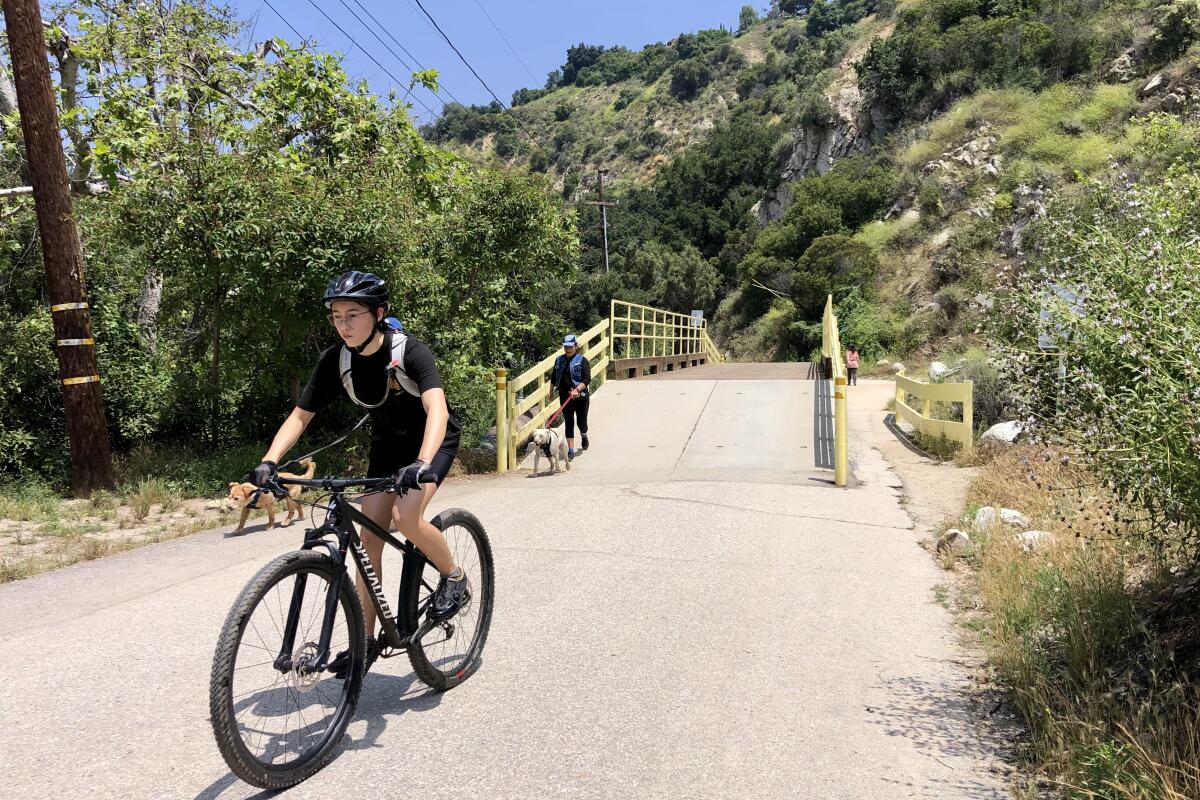
This trail is popular, and for good reason. On the weekend you’ll share it with horseback riders, cyclists, and plenty of families with strollers, but it’s a very wide path that can accommodate many adventurers. This is a great hike any time of year, but especially in the winter and spring, when the Arroyo Seco gushes with water. You’ll walk along the river for much of the journey.
The concrete is patchy in places but mostly intact, making for a leisurely trip in a wheelchair. You’ll see NASA’s Jet Propulsion Laboratory to your left at the start of the hike, which becomes progressively more shaded thanks to the coast live oaks, pink peppercorn trees, maples and pines. Two accessible footbridges will take you over the Arroyo Seco. Turn around when the paved path ends at just under a mile.



